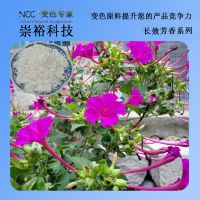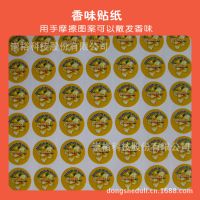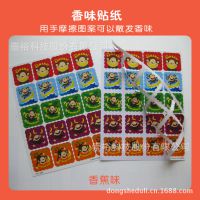
| 是否进口:否 | 产地:佛山 | 型号/规格:TM-PDF 38 |
| 品牌:崇裕 | 着色力≥:100 | 用途范围:注塑 油墨 涂料 |
| 货号:MC180618 | 色光:100 | CAS:63123-04 |
| 吸油量≤:30% | 特色服务:调色 |
崇裕科技变色颜料
台湾崇裕科技股份有限公司专业研发、生产长效夜光粉、变色特种颜料及成品的公司,公司成立于1987年。拥有颜料与成品的生产基地和配套设备,公司产品***环保符合ROHS、欧盟玩具认证EN71-3。
油墨系列:夜光油墨、夜光油漆(涂料)、变色油墨、变色油漆(涂料)、紫外线感光油墨、感温油墨、感香油墨、遇水变色油墨(滴水消失油墨)、紫外荧光防伪油墨、刮刮银、单组分金属玻璃油墨、镜面银油墨。
变色粉系列:感温粉、感光粉(UV光变粉)、紫外荧光防伪粉。
成品系列:夜光标牌、紫外线测试卡、保健体温测试卡、心情测试卡、液晶温度计、液晶变色片、感温变色贴、夜光贴、香味贴。
业务联系方式:刘先生 手机微信:18102547807 电话:020-32354951-3 传真:020-32354950 QQ:59752566
感温变色材料 THERMOCHROMIC MATERIAL
一、原理
微胶囊包覆著隐形染料、色形成剂及控温剂。藉由不同的控温材料先择,可制作出不同的温度区间变色的色料。
二、产品描述
A、变色原则:低温显色而高温无色
B、可提供产品范围:-15℃~70℃
C、基本颜色:各温度可提供15色(70℃仅提供黑色及深蓝色),各色可互相混合,亦可添加其它色料调色,(以下颜色为印刷色,以实际材料为准,颜色近似于PANTONE色号标准。)
三、产品形态及使用说明
A、产品形态与适用表
应用 材料
| 水乳液 | 微胶囊粉 | 色母粒 |
油性:油墨涂料 | × | ○ | × |
水性:油墨涂料 | ○ | △ | × |
塑胶射出、压出 | × | △ | ○ |
○适用,△可以,×不适用。
B、感温水乳液
a.产品说明:
感温水乳剂产品的平均粒径3-10um,是一种含有微胶囊的水性分散液,固含量约45%(±5%)。
b.产品特性:
于水中分散性佳,适用于水性油墨及涂料。
c.建议用量(例:成膜20um)
水乳液使用于水性油墨、涂料。
d.注意事项
避免高极性溶剂如:甲醇、乙醇、丙铜、丁铜混合使用,以避免渗透作用影响微胶囊中的组成。
感温水乳液储存期间若有凝集分层为正常现象,可以将其搅拌并用水浴加热45℃重新分散后再使用。
PH值改变可能影响颜色变化。
C、感温微胶囊粉
a.产品说明:
感温微胶囊粉平均粒径为1-10um,是一种复合配方组成的微胶囊粉,含水率≦3%
b.产品特性:
感温微胶囊粉为颜料,特点为有很好的耐溶剂性和分散性,适合用于油墨、涂料及塑胶射出、压出。
c.建议用量(例:成膜20um,塑胶成型0.2cm)
感温微胶囊粉使用于水性及油性油墨、涂料 5%~30%W/W(25%)
感温微胶囊粉使用于塑胶射出、压出 0.1%~5%W/W(0.5%)
d.注意事项
油墨应用时避免高极性溶剂如:甲醇、乙醇、丙铜、丁铜混合使用,以避免渗透作用影响微胶囊中的组成。
应用于塑胶加工时,避免温度超过230℃。
D、感温色母粒
a.产品说明:
感温色母粒含有约12%~18%的微胶囊材料,不同色系的微胶囊材料色彩强度不同,用在塑胶射出、压出产品使用比例需自行调整。
b.产品特性:分散及使用容易,可直接应用于塑胶射出及压出。
c.建议用量(例:塑胶成型0.2cm)
感温色母粒使用于塑胶射出、压出 1%~5%W/W(1%)
d.注意事项
我司标准母粒是PE母粒。
避免只添加酚系列热安定剂,会造成产品功能受损。
光安定剂和UV吸收剂的选择也可能造成产品功能影响。
四、补充说明
五、其它资讯
A、保存及期限:需储存于干燥及阴凉处。除深蓝色、草绿色、土耳其蓝及咖啡色保存期限为半年之外,其余颜色保存期限2年。
B、检测报告:本公司感温变色系列产品通过EN-71及RoHS测试。
thermochromic material
1.introduction
the core conterts of thermochromic microcapsule are leuco-dye,color developers and temperature controllers. by formulated with different temperature controllers, thermochromic products come in various activation temperatures.
duct description
lor conversion: when the temperature is raised to a specified temperature, it goes from colored to colorless. it returns to the original color as the temperature cools down.
B.available activation temperatures: -15oC~70oC
lor: 1***vailable colors for each activation temperature. all colors can be mixed with each other or added other pigments.
3. applications
A.available products applicability
available products | slurry | microcapsulated powder | masterbathcf |
lnk/paint(solvent) | χ | O | χ |
lnd/paint(aqueous) | O | Δ | χ |
plastic injection/extrusion | χ | Δ | O |
O applicable Δ conditionally applicable χ not applicable
B.thermochromic slurry
a. product description
thermochromic slurry is aqueous dispersion containing microcapsules and 48% of solid content. its average paticle size of the slurry is 3-7μm.
b. properties
good dispersal in water, suitable for aqueous based screen printing, paint, and ink.
c. recommended concentrations
for aqueous based ink/paint 5%~60%w/w
(for best results, baout 25% concentration is required for 20μm film thickness)
d. general recommendations
avoid high polarity solvents, such as, methanol, ethanol, acetone and methyl-ethyl-ketone, which will affect the microcapsules content through permeation.
slurry may clump together during storage, which can be heated with a double boiler to disperse.
changes of PH may cause changes of color conversion.
C. thermochromic microcapsulated powder
a. product description
consist of multiple formulations, containing moisture ≤3%. its average particle size is 3~12μm.
b. properties
with good solvent resistance and dispersal, thermochromic microcapsulated powder can withstand processing temperatures up to 240oC, suitable for ink/paint and plastic injection/extrusion.
c. recommendded concentrations
for solvent/ aqueous based ink/paint 5%~30%w/w
(for best results, about 25% concentration is required for 20μm film thickness)
for plastic injection/extrusion 0.1%~5%w/w
(for best results, about 0.5% concentration is requiured for 0.2cm plastic thickness)
d. general recommendations
avoid high polarity solvents, such as methanol, ethanol, acetone and methyl ethyl ketone, which will affect the microcapsules content through permeation.
the processing temperature of injection molding should not be over 240oC.
D. thermochromic masterbatch
a. product description
NCC thermochromic masterbatch contains 12%~18% of microcapsules depending on the different color formulations.
b. properties
dispersed and used easily, can be directly applied to plastic injection/extrusion.
c. general recommendations
for plastic injection/extrusion 1%~5%w/w
(for best results, about 0.5% concentration is required for 0.2cm plastic thickness)
d. general recommendations
standard masterbatch is PE masterbatch. please check the properties of PE for applications.
do not add phenol type heat stabilizers only, which may destroy the color changing properties.
UV stabilizer/absorbent may affect the color changing properties.
4. miscellaneous
A. chart of color change to temperatures : exp. 31oC red
when temperature is going up to 26.5oC, red color begins fading. the color completely disappears at 33oC.
when temperature is going down to 27.5oC, red color begins appearing. the color is strongest at 33oC.
please note each color has its specific activation temperatures. the heat conduction speed of base materials does affect the thermochromic products reactions to temperatures.
5. others
A. storage: keep sealed in a dark, cool place, away from direct sunlight. best within two years.
B.certifications: EN-71 RoHS passed. safe for food grade packing and toys.




